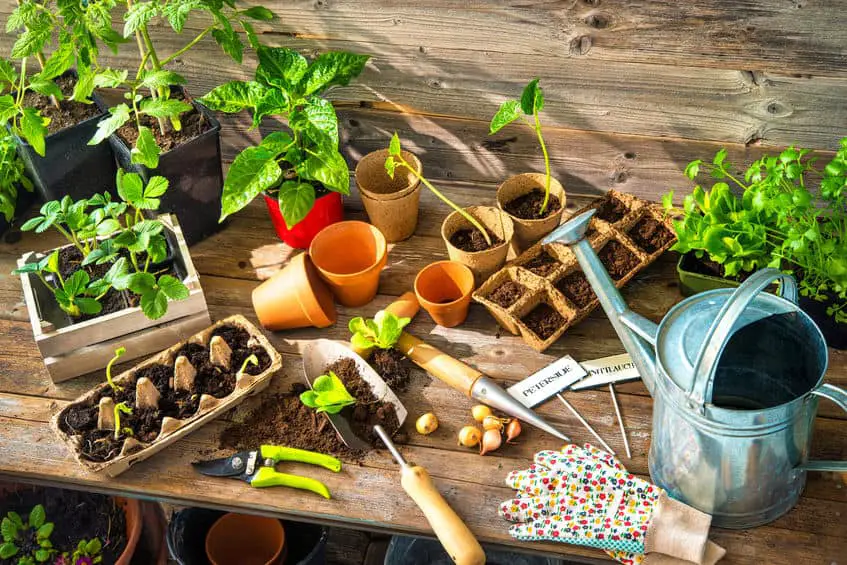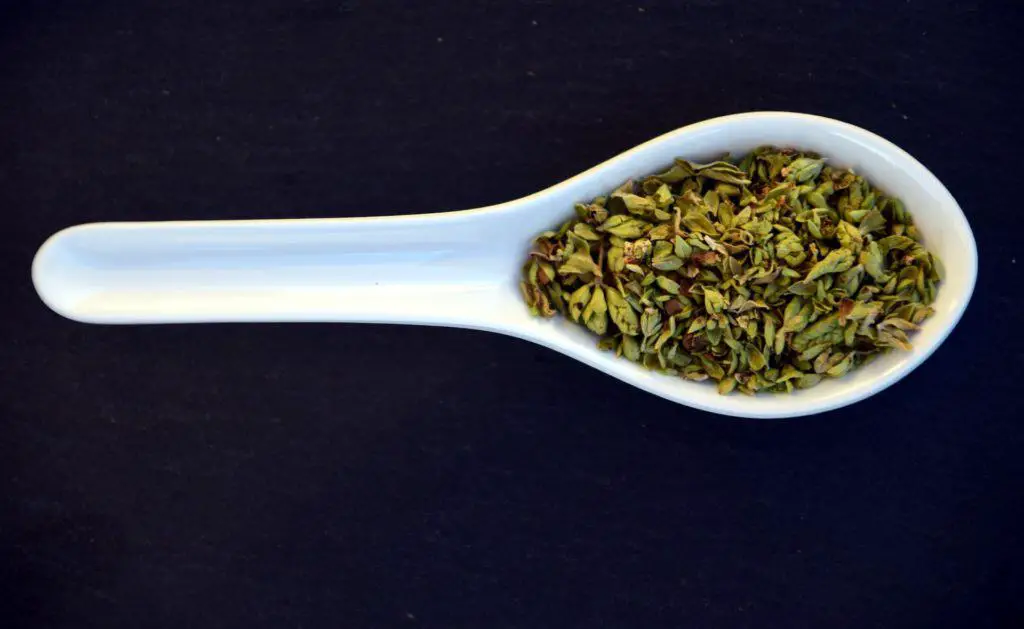Oregano is quite easy to grow and it can be grown indoors at home. It requires little attention, so it is perfect for gardening beginners.
In this guide, I will tell you everything, that you need to know to grow your oregano plant successfully! So let´s start with some basic Information about Oregano.
Oregano is part of the mint family and it is very closely related to the Marjoram plant. Oregano is also sometimes called “wild marjoram”.
The word oregano originates from the Greek language and means “Mountain Brightness”
Different Varieties Of Oregano
There are a lot of different Oregano varieties, that slightly differ by taste and look. Some can be used as ornamental plants.
Oregano Vulgare
This variety serves as the most common oregano species and also comes by the name wild marjoram or true oregano. It’s a dynamic grower with a mild flavor.
Sweet Marjoram
Marjoram also belongs to the oregano genus. This herb has a similar taste to oregano but sweet and less spicy.
Golden Oregano
This oregano variety can be used as an ornamental plant. It’s a creeping herb that has foliage in shades of gold.
This herb is ideal for hanging baskets and wide containers. Compared to the Greek oregano, it has a milder flavor.
Greek Oregano (Origanum Vulgare Var.Hirtum)
This variety has an earthy and pungent flavor, and it’s used mainly in Italian and Greek dishes.
The Greek oregano doesn’t spread robustly as the ordinary oregano. It’s commonly used to flavor meat, fish, and tomato sauce and pizza recipes.
Syrian Oregano (Origanum Maru)
This oregano variety doesn’t spread like the other oregano species.
It rather grows upright to a height of 3-4 feet. It has a strong flavor, and it’s popular in Middle Eastern cuisine.
Italian Oregano (Origanum X Majoricum)
This is a hybrid of sweet oregano and common oregano. Since it’s a hybrid variety, it has a milder flavor than the Greek oregano.
Its taste is similar to marjoram and the Greek oregano.
Mexican Oregano (Lippia Graveolens)
The Mexican oregano belongs to the Verbena family. It has a strong and aromatic flavor, and it’s mainly used in Mexican cuisine.
It grows better in frost-free and warm climates (USDA Zones 8-11). It’s able to tolerate heat and sunny conditions.
How To Grow Oregano Indoors In Pots
Just like most herbs, growing oregano in containers is pretty easy.
If you’re a fan of Mediterranean cuisine, then it’s vital to grow this herb at home. If your house has sunny windowsills growing oregano indoors becomes easier.
Propagation Of Oregano
You can propagate oregano in three ways: cuttings seeds and divisions.
Oregano seeds are very small, it’s recommended to tap the seeds in the pot and cover lightly with a layer of soil.
If you want to propagate oregano by divisions, the ideal time is in spring. Plant the divisions in a separate pot.
It’s also possible to propagate oregano from cuttings.
Use cuttings from a healthy young plant usually 3 to 5 inches. Remove most of the leaves from the plant and soak it in rooting hormone before planting.
Tips: If you’re new to planting oregano, it’s advisable to buy several oregano transplants from an established nursery. This will reduce the hassles of sowing oregano seeds and waiting for germination. When your plants mature, you can then increase your plants by planting cuttings.
If you want oregano plants with the same flavor and quality to the original plant, it’s advisable to use cuttings or divisions.
What Are The Best Containers For Growing Oregano?

Containers for planting herbs indoors are made of various materials.
You can either select terracotta, glazed ceramics, concrete, wooden or plastic containers for your oregano plants.
Concrete, ceramic, and terracotta containers are the most durable containers for your indoor herbs though they may be costly, especially for large sizes.
A container with a diameter of 10-14 inches is perfect for growing oregano plants.
The height of the containers should be between 8-10 inches. But you should recognize that the type of container you’ll use for the oregano plants depends on the variety.
For example, you can grow low varieties such as the golden and creeping oregano in wide but shallow containers about 6-8 inches deep.
Tall varieties such as the Mexican and Lebanese oregano should be grown in big containers at least 2 inches.
What Is The Best Soil For Growing Oregano?
Oregano plants thrive in well-drained, light and fertile soils. You can add 1/3 part of aged manure of compost in the potting soil to increase organic matter. The ideal soil pH for oregano is between 6.7 -7.0.
These plants require moderate soil fertility and may even do well in poor but well-drained soils.
Alternative Growing Media For Your Oregano Plants
If you don t want to use soil for your container oregano plants, you can use alternative growing media such as Rockwool, perlite, soilless potting mixes (Sunshine Mix, Pro-Mix, etc.), coco peat, etc.
But remember these alternative media are best when you’re raising the plant in the nursery.
Repotting
Oregano plants grow rapidly to cover the pot; it’s advisable to cut the plant if it becomes uncontrollable.
This will eliminate the need for repotting. The best advice is to replace the plant once the soil in container shows signs of exhaustion; this is typically after six months.
You should only repot oregano once; from the plastic nursery pot to the permanent clay pot.
Seed germination period
In 8-14 days your oregano seed will germinate.
But they may germinate faster in 7-10 days if you use propagation media such as Rapid Rooters, Oasis Rootcubes or Grodan Stonewool.
Planting And Spacing
You should sow your seeds at a depth of ¼ inch deep.
In the nursery thin seedlings. Transplant each oregano plant into a container about 12 inches in diameter, but remember the size of the pot will depend on the variety.
How To Transplant Your Oregano Plants
- Before transplanting your oregano plants, it’s essential to water the plants in the nursery in the morning if you plan to transplant them in the evening.
- Dig around the plant to about 4-5 inches and lift the root ball from the soil. Make sure the plant has most of its roots for faster germination and to minimize the effects of transplanting shock.
- Plant the oregano plant in the selected pot, ensuring the pot is large enough to accommodate the root ball. Make sure to use high-quality potting soil. The plant should be planted at a similar depth to how it was in the nursery.
- Press the soil around the plant firmly.
- Water the plants until water seeps from the drainage hole at the bottom of the container.
- Your plants should be placed in an area that receives at least 6 hours of sunlight or approximately 14 hours of artificial light.
How To Care For Your Oregano Plants
Watering
You should water your oregano, every time you feel the topsoil is dry to touch. But be careful not to overwater this plant.
Oregano doesn’t demand much water like mint. You’ll enjoy great aromatic flavor if you ensure the plants aren’t overwatered.
Sunshine
Oregano will thrive well in partial to full sunlight, but you’ll get a better flavor if you grow the plant in full-day sunshine.
When growing these plants indoors, make sure they receive adequate sun and heat.
Natural light
In the chilly winter, note south-facing windows have the highest amount of sunshine beside most hours of sunlight.
Thus this is the ideal location for your indoor herbs such as oregano, basil, thyme, and bay laurel.
The east-facing windows receive about six hours of sunshine per day, and most remain color.
These aren’t ideal locations for oregano but herbs that prefer cooler temperatures such as parsley, mint, chervil, and chives
Grow lights
All herbs grown indoors will thrive better if you use full-spectrum grow lights if they can’t access adequate sunlight.
The plants should be at a distance of a foot from the grow bulbs; read and follow the instructions given by the manufacturer. Adjust the light requirements depending on the plant.
If you’re growing oregano using these lights you can have the lights on for 8-12 hours each day.
Pruning
If your oregano plants are bushy, you’ll need to prune them while they’re still young. Your indoor oregano plant should be at least 4 inches high.
Once they have achieved this height pinch the top of the plant above the leaf node; this will ensure you have a lush and robust plant.
Fertilizing
It’s important to note; oregano doesn’t require high soil fertility.
If you had previously added aged manure or compost to your potting soil, there’s no need to fertilize the plants not unless the plants display stunted growth.
If you never used aged manure or compost in your oregano, you may have to use organic fertilizers such as compost tea or fish emulsion.
Alternatively, you may apply 10-10-10 liquid fertilizer or NPK 5-10-5, once or twice every month.
Note: Over-fertilizing your oregano will affect the flavor and aroma.
Pests & diseases
Oregano may suffer root ort if exposed to excess water.
You should also scout for garden pests like spider mites, and aphids that attack the plants.
Companion planting
Oregano can grow next to any plant, but if you are growing the plants indoors, it’s advisable not to interplant with other plants in the same container.
You can plant them close to tomatoes, peppers, etc. Although aphids love oregano, the plants also attract flower flies (syrphidae) that feast on aphids; thus, they can be excellent plants to grow close to tomatoes.
Harvesting Oregano

Harvesting oregano is simple; it’s prudent to let the plant grow to about 4 inches then pinch the plant’s top to encourage new growth and prevent the plant from growing too high.
You may even allow the oregano to grow to eight inches the cut back to about 2/3rds.
An easy way of harvesting oregano is to grab the stem and remove the leaves to about 2/3rds of the stem; later cut the leafless stem to allow new growth. This method is suitable if you want to use fresh leaves.
If you want to get the best flavor from your plant, it’s wise to harvest the leaves as the plant approaches flowering. But still, thinly flowered oregano will still be perfect for salads.
When harvesting your oregano leaves clip as desired or trim all the oregano plants and turn them to your dehydrator.

